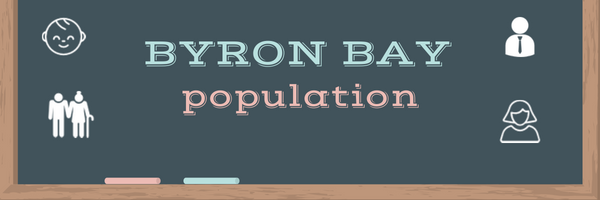
Byron Bay is a New South Wales city located on 772km north of Sydney and 165km south of Brisbane. Byron Bay is right at the north tip of NSW. With a population over 9,000, the city is one of the least populous place in NSW.
Based on our research, Byron Bay population will reach 10,241 by the end of June 2023. We use end of June each year due to Australian Bureau of Statistics (ABS) always follow Australian financial year when published the data. The calculation is based on the average growth rate of 1.30% over last twelve years since 2011. We believe using the recent years’ figures (see the table in next section) will make the estimation more accurate.
Population Growth of Byron Bay
Looking back last twelve years of Byron Bay’s population, overall the growth rate is very consistent and healthy ranging from 0.34% to 2.01%, adding around 30 to 180 people each year to the overall population. If you compare the 2011 and 2016 census figure, the growth rate is 6.8% over 5 years period. The reasons contribute to the population growth is that employment rate and birth rate are very steady in Byron Bay. Also coastal or beach life style attracts young people and retirees to stay. The growth is pretty much align with the national population growth.
| Year | Population | Growth rate |
| 2011 | 8,655 | n/a |
| 2012 | 8,760 | 1.21% |
| 2013 | 8,790 | 0.34% |
| 2014 | 8,960 | 1.93% |
| 2015 | 9,140 | 2.01% |
| 2016 | 9,246 | 1.16% |
| 2017 | 9,360 | 1.23% |
| 2018 | 9,483 | 1.31% |
| 2019 | 9,608 | 1.32% |
| 2020 | 9,720 | 1.30% |
| 2021 | 9,840 | 1.23% |
| 2022 | 9,990 | 1.52% |
| 2023 | 10,110 | 1.20% |
Demographics of Byron Bay
According to census, 48.1 percent of people living in Byron Bay are male, while 51.9% are female. Average age in Byron Bay is 41. The top countries of birth are: Australia 64%, England 4.9%, New Zealand 2.5%, United States of America 1.1%, Germany 0.9% and Brazil 0.7%. The top spoken languages at home are: English 76.3%, Italian 1.0%, French 1.0%, German 0.9%, Spanish 0.8% and Portuguese 0.8%.
The religious groups in Byron Bay consist of:
No Religion, so described 44.6%, Not stated 20.0%, Catholic 13.2%, Anglican 9.4% and Uniting Church 2.5%. In Byron Bay, No Religion, so described was the largest religious group reported overall (55.8%)
Population Density of Byron Bay
Byron Bay population density is 130 people per square kilometer.
Occupations and Industries
According to census, the main occupations of people living in Byron Bay are Professionals 25.2%, Managers 16.1%, Technicians and Trades Workers 13.1%, Community and Personal Service Workers 13.1%, and Sales Workers 9.9%.
The main industries people from Byron Bay work in are 7.1% worked in Accommodation. Other major industries of employment included Cafes and Restaurants 6.0%, Clothing Retailing 2.3%, Secondary Education 2.3% and Other Social Assistance Services 2.1%.
In terms of working hours, 15.5% worked 1 to 15 hours, 14.8% worked 16 to 24 hours and 32.5% worked 40 hours or more.
Facts About Byron Bay
- Today, Byron Bay is one of the most up-market residential areas on the Australian east coast with the growth in multi-million dollar mansions now pushing the median value of house sales up beyond AU$1.5 million in 2017.
- The first industry in Byron was cedar logging from the Australian red cedar.
- The lighthouse was built in 1901 at the most easterly point on the Australian mainland.
- Byron Bay is now also a popular destination for Schoolies week during late November and early December.
- Average summer temperatures are 21C – 28C, and average winter temperatures are 15C – 21C.
- In Byron Bay, of people aged 15 years and over, 32.6% of people were in a registered marriage and 15.5% were in a de facto marriage.
References
The following links provide data for this topic:The following links provide data for this topic:
- Australian Bureau of Statistics: www.abs.gov.au
- New South Wales Government: www.nsw.gov.au
- Byron Bay Council: www.byron.nsw.gov.au
